To brew hibiscus tea for lowering blood pressure, use 1-2 teaspoons of dried hibiscus flowers per 8 ounces of water. Heat water to just below boiling (200°F or 93°C), then steep for 5-10 minutes. Strain and serve hot or cold, optionally adding honey or lemon for taste. Drink 2-3 cups daily, ideally 30 minutes before meals or 2-3 hours after. Use organic flowers for best quality and flavor. Remember to monitor your blood pressure regularly and consult your doctor before making significant dietary changes. By mastering the art of brewing hibiscus tea, you'll reveal its full potential for supporting heart health.
Understanding Hibiscus Tea's Health Benefits
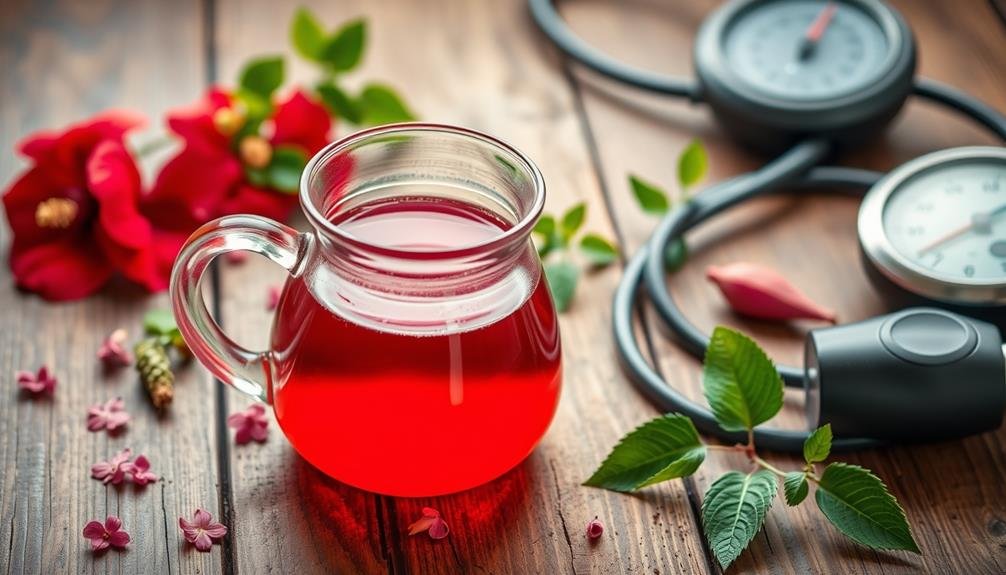
While many people enjoy hibiscus tea for its tart, invigorating flavor, it's essential to recognize that it's also packed with potential health benefits. Hibiscus tea is rich in antioxidants, particularly anthocyanins and polyphenols, which help protect your body from free radical damage. These compounds may contribute to reducing inflammation and supporting overall health.
One of the most notable benefits of hibiscus tea is its potential to lower blood pressure. Studies have shown that regular consumption of hibiscus tea can help reduce both systolic and diastolic blood pressure in individuals with mild to moderate hypertension. This effect is thought to be due to the tea's ability to act as a natural diuretic and vasodilator.
Hibiscus tea may also support weight management by inhibiting the production of amylase, an enzyme that breaks down carbohydrates and starches. This can potentially lead to reduced carbohydrate absorption and lower blood sugar levels.
Additionally, the tea has been linked to improved liver health, cholesterol reduction, and boosted immune function. However, it's crucial to acknowledge that while these benefits are promising, more research is needed to fully understand the extent of hibiscus tea's health effects.
Selecting Quality Hibiscus Flowers
When selecting hibiscus flowers for your tea, you'll need to choose between dried and fresh options, with dried being more widely available.
It's essential to source organic flowers to avoid pesticides and guarantee the best flavor.
Look for vibrant, deep red petals and a strong, tart fragrance as indicators of high-quality hibiscus.
Dried vs. Fresh Flowers
Selecting high-quality hibiscus flowers is essential for brewing a flavorful and aromatic tea. When choosing between dried and fresh flowers, you'll find that each option has its advantages.
Dried hibiscus flowers are more readily available and have a longer shelf life. They're convenient for storing and using year-round. You'll find that dried flowers offer a more concentrated flavor, requiring fewer petals per cup of tea. They're also easier to measure accurately for consistent brewing.
Fresh hibiscus flowers, on the other hand, provide a brighter, more vibrant flavor profile. They contain higher levels of vitamin C and antioxidants, which may offer additional health benefits. However, fresh flowers are seasonal and can be challenging to source. They also have a shorter shelf life and require more preparation time.
If you opt for dried flowers, look for ones that are deeply colored and fragrant. Avoid flowers with discoloration or a musty odor.
For fresh flowers, choose petals that are firm and free from blemishes. Regardless of your choice, verify the flowers are organically grown and free from pesticides to maximize the potential health benefits of your hibiscus tea.
Organic Sourcing Importance
In light of the growing concern for health and environmental sustainability, choosing organic hibiscus flowers is essential for brewing the best quality tea. Organic hibiscus flowers are grown without synthetic pesticides or fertilizers, ensuring that your tea is free from harmful chemicals that could potentially negate its health benefits.
When sourcing organic hibiscus, look for reputable suppliers who can provide certification. This guarantees that the flowers meet strict organic standards and have been cultivated using sustainable practices.
Organic hibiscus often has a richer flavor profile and higher concentration of beneficial compounds, such as antioxidants and vitamin C.
You'll also want to reflect on the origin of the hibiscus flowers. Different regions produce hibiscus with varying taste characteristics and potential health benefits.
For example, Egyptian and Sudanese hibiscus are known for their deep red color and tart flavor, while hibiscus from Thailand tends to be milder.
Color and Fragrance Indicators
Once you've found a trustworthy organic supplier, you'll need to assess the quality of the hibiscus flowers themselves.
Look for vibrant, deep red petals that indicate freshness and potency. High-quality hibiscus flowers should have a rich, almost burgundy hue. Avoid flowers that appear faded or brown, as these may be old or improperly stored.
The fragrance of the hibiscus flowers is another vital indicator of quality. When you open the package, you should detect a pleasant, slightly tart aroma reminiscent of cranberries or raspberries.
If there's little to no scent, or if it smells musty or off, the flowers may be past their prime.
Texture is also important. The dried petals should feel crisp and break easily when bent, but they shouldn't crumble into dust.
Overly moist or sticky flowers might indicate improper drying or storage, which can lead to mold growth.
Required Equipment for Brewing

Brewing hibiscus tea doesn't require fancy equipment. You'll need a few basic items to get started. First, grab a kettle or pot to boil water. If you don't have one, a microwave-safe container will work too.
You'll also need a teapot or a large mug for steeping the tea. To measure the dried hibiscus flowers, use a tea infuser, tea ball, or reusable cloth tea bag. If you don't have these, a fine-mesh strainer will do the job.
For precise measurements, keep a kitchen scale or measuring spoons handy. Don't forget a timer to guarantee proper steeping time. A regular kitchen timer or your smartphone will suffice.
You'll also need a spoon for stirring and a cup for serving the finished tea. If you plan to make iced hibiscus tea, have a pitcher and ice cubes ready. For sweetening, keep honey, stevia, or your preferred sweetener nearby.
Measuring the Perfect Amount
For a perfect cup of hibiscus tea, measuring the right amount of dried flowers is vital. The general rule of thumb is to use 1 to 2 teaspoons of dried hibiscus flowers per cup (8 ounces) of water. If you prefer a stronger brew, you can increase this to 1 tablespoon per cup.
When measuring, use a standard measuring spoon rather than eyeballing it. This guarantees consistency in your brew and helps you find your ideal strength. If you're making a larger batch, simply scale up the measurements proportionally. For example, for a quart (32 ounces) of tea, you'd use 4 to 8 teaspoons of dried flowers.
Keep in mind that hibiscus tea can be quite tart, so you might want to start with a lower amount and adjust to your taste.
If you're using fresh hibiscus flowers instead of dried, you'll need to use more – about 2 to 3 flowers per cup of water.
Remember that the strength of your tea will also depend on steeping time, so you can experiment with both measurements and steeping duration to find your perfect balance.
Water Temperature and Quality
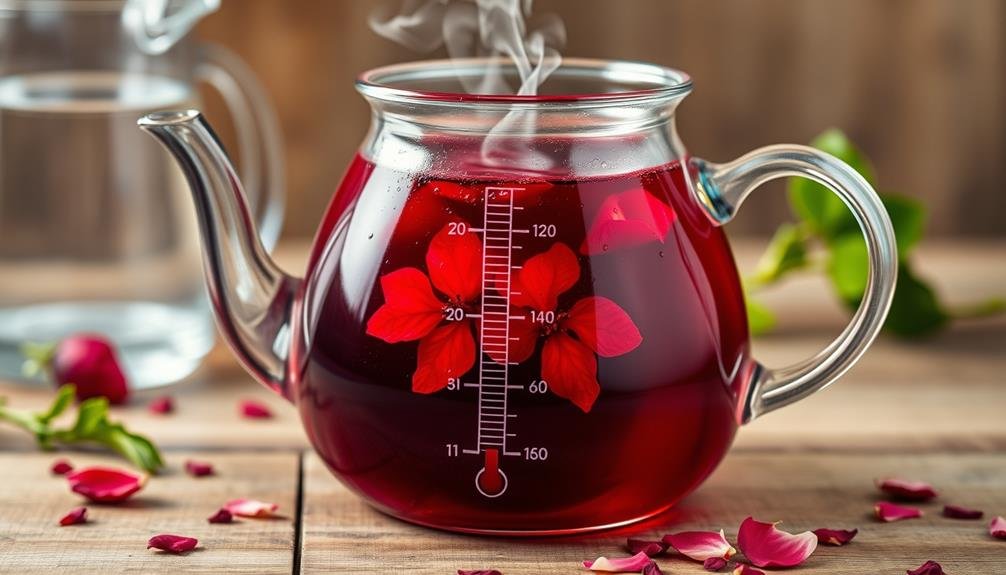
You'll want to heat your water to between 190-205°F (88-96°C) for ideal hibiscus tea brewing.
Consider using filtered water instead of tap water to enhance the tea's natural flavors and avoid any unwanted mineral tastes.
The quality of your water greatly impacts the final taste of your hibiscus tea, so choose wisely for the best results.
Ideal Water Temperature Range
To achieve the perfect cup of hibiscus tea, water temperature plays a crucial role. The ideal range for brewing hibiscus tea falls between 190°F to 212°F (88°C to 100°C). This temperature range allows for the best extraction of the tea's beneficial compounds, including anthocyanins and vitamin C, which contribute to its potential blood pressure-lowering effects.
If you're using an electric kettle with temperature control, set it to 200°F (93°C) for best results. For those without a thermometer, bring water to a full boil and let it cool for about 30 seconds before pouring it over your hibiscus flowers or tea bags. This brief cooling period guarantees you're within the ideal temperature range.
Avoid using water that's too hot, as it can lead to over-extraction, resulting in a bitter taste. Conversely, water that's too cool won't extract enough flavor and beneficial compounds, leaving you with a weak, less effective brew.
Filtered vs. Tap Water
When brewing hibiscus tea, the choice between filtered and tap water can considerably impact the final taste and quality of your beverage. Filtered water is often preferred as it removes impurities and contaminants that might affect the tea's flavor.
Tap water, on the other hand, can contain minerals and chemicals that may alter the taste or even react with the hibiscus flowers.
If you're using tap water, consider these factors:
- Chlorine content: High levels can impart an unpleasant taste.
- Water hardness: Excessive minerals can make the tea cloudy.
- pH level: Acidic or alkaline water may affect the tea's flavor profile.
Filtered water provides a more consistent base for your hibiscus tea, ensuring that the natural flavors of the flowers shine through.
It's especially important if you're brewing tea for its potential health benefits, as you'll want to avoid introducing any unwanted elements into your drink.
If you don't have access to a water filter, you can improve tap water by letting it sit for a few hours, which allows chlorine to dissipate.
Alternatively, boiling the water before use can help eliminate some impurities and improve the overall taste of your hibiscus tea.
Water's Impact on Flavor
The quality and temperature of water play a significant role in extracting the ideal flavor from hibiscus flowers. You'll want to use water that's free from strong odors or tastes, as these can interfere with the tea's natural flavor. The temperature of your water also impacts the extraction process and final taste.
For best results, use water that's just below boiling point, around 200°F (93°C). This temperature helps release the hibiscus flowers' full flavor profile without making the tea overly bitter. If you're using cooler water, you may need to steep the tea longer to achieve the desired strength.
Here's a quick guide to water temperature and its effects on hibiscus tea:
| Temperature | Steeping Time | Flavor Profile | Best For |
|---|---|---|---|
| 200°F (93°C) | 5-7 minutes | Full-bodied, tart | Hot tea |
| 180°F (82°C) | 8-10 minutes | Milder, less acidic | Sensitive palates |
| 160°F (71°C) | 12-15 minutes | Subtle, less intense | Cold brew |
| Room temp | 8-12 hours | Smooth, less bitter | Iced tea |
Steeping Time for Maximum Effect
Steeping time plays a crucial role in extracting the full flavor and benefits from your hibiscus tea. To achieve the best balance of taste and health benefits, you'll want to steep your tea for 5 to 10 minutes. This duration allows the hot water to fully extract the beneficial compounds, including antioxidants and anthocyanins, which contribute to the tea's potential blood pressure-lowering effects.
If you prefer a stronger, more tart flavor, you can extend the steeping time up to 15 minutes. However, be aware that longer steeping times may result in a more bitter taste. For a milder flavor, stick to the lower end of the recommended range.
To make sure you're getting the most out of your hibiscus tea, follow these tips:
- Use a timer to track your steeping time accurately.
- Cover your cup or teapot while steeping to retain heat and flavor.
- Gently stir the tea once or twice during steeping for even extraction.
Straining and Serving Methods
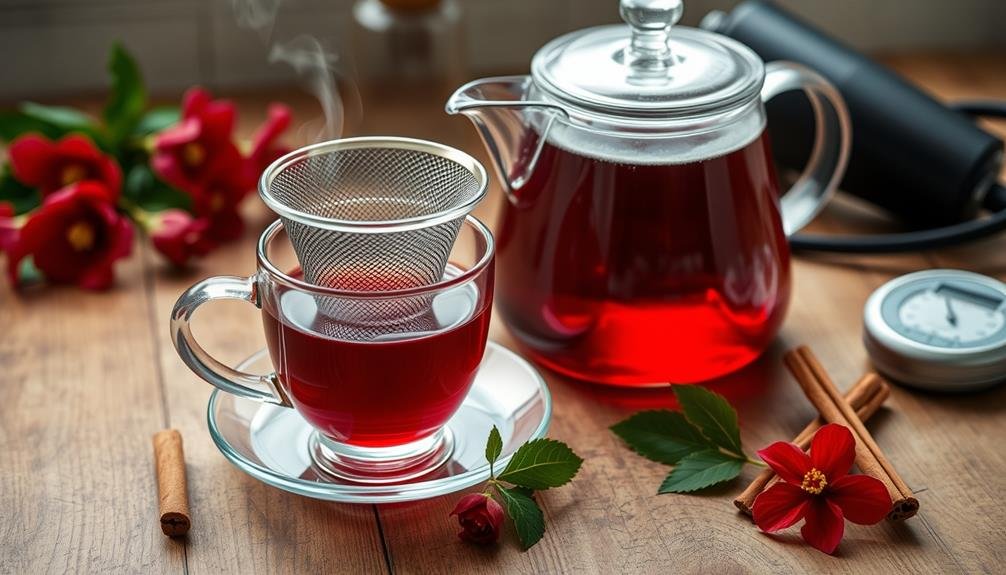
After your hibiscus tea has steeped to perfection, it's time to strain and serve this vibrant beverage. Place a fine-mesh strainer over your serving container and carefully pour the tea through it. This will catch any loose hibiscus petals or debris, ensuring a smooth drinking experience. If you prefer a clearer tea, you can use a cheesecloth or coffee filter for an extra-fine strain.
Once strained, you can serve your hibiscus tea hot or cold. For hot tea, pour it directly into cups and enjoy. If you prefer it cold, let it cool to room temperature before refrigerating. You can also add ice for an immediate chill, but be mindful that this may dilute the flavor.
Here's a quick guide to serving options:
| Serving Style | Additions | Benefits |
|---|---|---|
| Hot | Honey, lemon | Soothing, warming |
| Iced | Mint, lime | Invigorating, cooling |
| Room temp | Ginger, cinnamon | Spicy, aromatic |
Flavor Enhancements and Additions
While hibiscus tea boasts a naturally tart and invigorating flavor, you can spice it up with various additions to create a more complex and personalized beverage.
Consider adding honey or stevia to sweeten the tea without compromising its health benefits. For a zesty twist, squeeze in some fresh lemon or lime juice, which can enhance the tea's vitamin C content and boost its antioxidant properties.
If you're feeling adventurous, try these flavor enhancements:
- Infuse your hibiscus tea with fresh mint leaves for a revitalizing and cooling effect.
- Add a cinnamon stick or a pinch of ground cinnamon for a warm, spicy note.
- Blend in some ginger root or powder to create a spicy-sweet combination.
For a fruity variation, mix in a splash of unsweetened cranberry or pomegranate juice. These additions not only enhance the flavor but may also contribute additional health benefits.
If you prefer a creamier texture, try adding a small amount of plant-based milk like almond or coconut milk.
Optimal Consumption Frequency
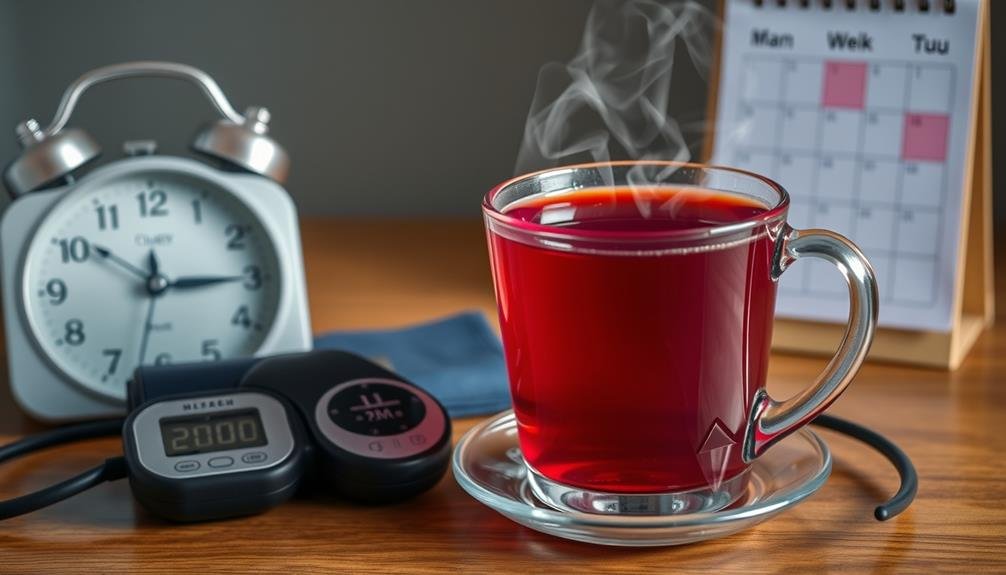
When it comes to enjoying hibiscus tea, you'll want to take into account both your daily and weekly intake.
You can safely consume 2-3 cups of hibiscus tea daily, but some people prefer to limit it to a few times a week.
For best benefits, try drinking a cup in the morning and another in the afternoon, avoiding consumption too close to bedtime.
Daily vs. Weekly Intake
Many wonder about the ideal frequency for drinking hibiscus tea. While daily consumption can offer consistent benefits, some may prefer a weekly routine. Research suggests that regular intake is key to reaping the blood pressure-lowering effects of hibiscus tea.
If you're aiming for daily consumption, consider having 1-2 cups spread throughout the day. This approach can help maintain a steady level of beneficial compounds in your system.
For those opting for a weekly routine, aim for 3-4 cups spread over 2-3 days. This method can still provide noticeable benefits while allowing for variety in your beverage choices.
When deciding between daily and weekly intake, consider these factors:
- Your current blood pressure levels
- Any medications you're taking
- Your overall health and lifestyle
Timing Throughout the Day
Throughout the day, you'll want to time your hibiscus tea consumption for ideal benefits. Research suggests that drinking hibiscus tea at specific times can maximize its blood pressure-lowering effects. Aim to consume your tea about 30 minutes before meals or 2-3 hours after eating. This timing helps enhance absorption and effectiveness.
Consider spreading your intake across the day to maintain consistent benefits. You might drink a cup in the morning, another in the afternoon, and a final cup in the evening. However, avoid consuming hibiscus tea too close to bedtime, as its mild diuretic effects could disrupt your sleep.
Here's a suggested daily schedule for optimal hibiscus tea consumption:
| Time of Day | Recommended Intake | Notes |
|---|---|---|
| Morning | 1 cup | 30 minutes before breakfast |
| Midday | 1 cup | 30 minutes before lunch |
| Afternoon | 1 cup | 2-3 hours after lunch |
| Evening | 1 cup | 2-3 hours after dinner, before 7 PM |
Remember to listen to your body and adjust your intake as needed. If you're sensitive to caffeine, you may want to avoid evening consumption. Always consult with your healthcare provider before making significant changes to your diet or supplement routine.
Potential Side Effects
While hibiscus tea offers numerous health benefits, it's important to be aware of potential side effects. If you're taking medications or have certain health conditions, consult your doctor before incorporating hibiscus tea into your routine. Hibiscus can interact with some medications, especially those for high blood pressure or diabetes.
Be cautious if you're pregnant or breastfeeding, as hibiscus may affect hormone levels and potentially lead to complications. If you have low blood pressure, drinking hibiscus tea might cause it to drop further, leading to dizziness or fainting.
Here are three key side effects to watch out for:
- Increased risk of bleeding: Hibiscus may interfere with blood clotting, so avoid it before surgery or if you're on blood thinners.
- Liver toxicity: In rare cases, excessive consumption may lead to liver problems.
- Allergic reactions: Some people may experience allergic symptoms like itching, swelling, or difficulty breathing.
Monitor your body's response when you start drinking hibiscus tea. If you experience any unusual symptoms, stop consuming it and seek medical advice.
Storing Hibiscus Tea

Now that you're aware of the potential side effects, let's focus on how to keep your hibiscus tea fresh and flavorful. Proper storage is essential to maintain the tea's quality and maximize its health benefits.
Store your dried hibiscus flowers in an airtight container, away from direct sunlight and moisture. A cool, dark place like a pantry or cupboard is ideal. If you've purchased pre-packaged tea bags, keep them in their original packaging until use.
For brewed hibiscus tea, it's best to consume it within 24 hours when stored in the refrigerator. If you've made a large batch, you can store it in a glass pitcher or jar with a tight-fitting lid.
Avoid leaving the tea at room temperature for more than 2 hours, as this can promote bacterial growth. If you want to keep it longer, consider freezing the tea in ice cube trays. These frozen cubes can be added to cold drinks or thawed for hot tea later.
When storing hibiscus tea concentrate, use a clean, airtight container and refrigerate for up to two weeks. Always check for any signs of spoilage, such as an off-smell or mold, before consuming stored tea.
Combining With Other Blood Pressure Remedies
Many people find that combining hibiscus tea with other natural remedies can enhance its blood pressure-lowering effects.
When you're looking to maximize the benefits of hibiscus tea, consider pairing it with other proven methods for managing hypertension. You'll want to consult your healthcare provider before making any significant changes to your diet or supplement regimen, especially if you're taking medications.
Here are three effective ways to combine hibiscus tea with other blood pressure remedies:
- Incorporate heart-healthy foods: Pair your hibiscus tea with a diet rich in fruits, vegetables, whole grains, and lean proteins.
- Add other herbal teas: Try blending hibiscus with green tea or chamomile for added antioxidant benefits.
- Include natural supplements: Consider taking omega-3 fatty acids or CoQ10 alongside your hibiscus tea routine.
Tracking Blood Pressure Results

To get the most out of your hibiscus tea regimen, you'll need to track your blood pressure results consistently. Start by establishing a baseline before you begin drinking hibiscus tea regularly. Measure your blood pressure at the same time each day, preferably in the morning before eating or drinking anything.
Use a reliable home blood pressure monitor and record your readings in a journal or smartphone app. Note the date, time, and any factors that might affect your blood pressure, such as stress, exercise, or medication changes. Take two to three readings each time, waiting a minute between measurements, and record the average.
As you incorporate hibiscus tea into your routine, continue monitoring your blood pressure daily. Look for trends over time rather than focusing on individual readings. After a few weeks, you should be able to see if the tea is having an effect on your blood pressure.
Don't forget to share your results with your healthcare provider. They can help interpret the data and adjust your treatment plan if necessary.
Frequently Asked Questions
Can Pregnant Women Drink Hibiscus Tea for Blood Pressure Control?
You shouldn't drink hibiscus tea if you're pregnant. It can affect hormone levels and potentially cause complications. While it may help with blood pressure, it's not safe during pregnancy. Consult your doctor for alternative options.
Does Hibiscus Tea Interact With Blood Pressure Medications?
You should be cautious if you're taking blood pressure medications. Hibiscus tea can interact with them, potentially enhancing their effects. It's best to consult your doctor before combining hibiscus tea with your prescribed medications.
Can Children Consume Hibiscus Tea for Its Health Benefits?
You can give children hibiscus tea, but it's best to consult a pediatrician first. While it's generally safe, it's not recommended for kids with certain health conditions. Moderation is key, as it's quite tart.
Is It Safe to Drink Hibiscus Tea Before Surgery?
You shouldn't drink hibiscus tea before surgery. It can interfere with blood clotting and affect blood pressure. Always inform your doctor about any herbal teas you're consuming and follow their pre-surgery instructions carefully.
Can Hibiscus Tea Help With Weight Loss in Addition to Lowering Blood Pressure?
Yes, hibiscus tea may help with weight loss. It's low in calories and can boost metabolism. You'll also feel fuller, potentially reducing snacking. However, it's not a magic solution – combine it with a healthy diet and exercise.
In Summary
You've now learned how to brew hibiscus tea to potentially lower your blood pressure. Remember to use quality flowers, measure carefully, and brew at the right temperature. Don't forget to monitor your blood pressure and consult your doctor about incorporating this tea into your health routine. While hibiscus tea can be beneficial, it's not a substitute for prescribed medications. Enjoy your homemade tea, but stay aware of any side effects and store it properly for the best results.

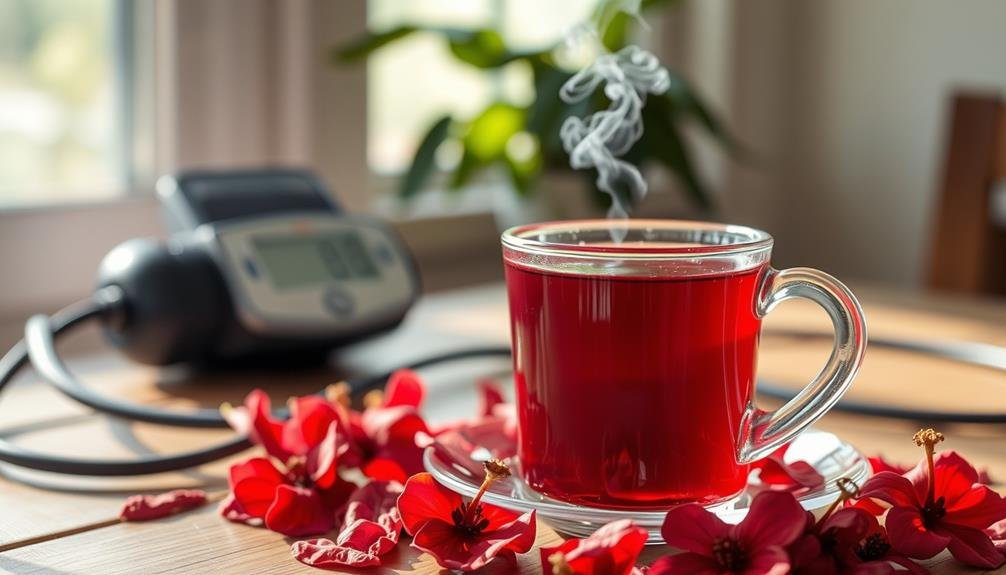
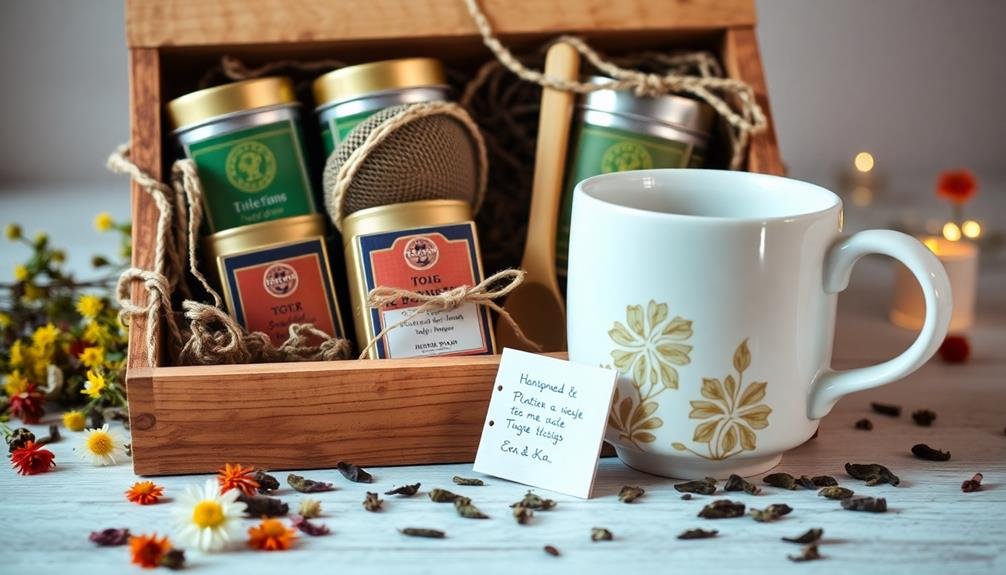
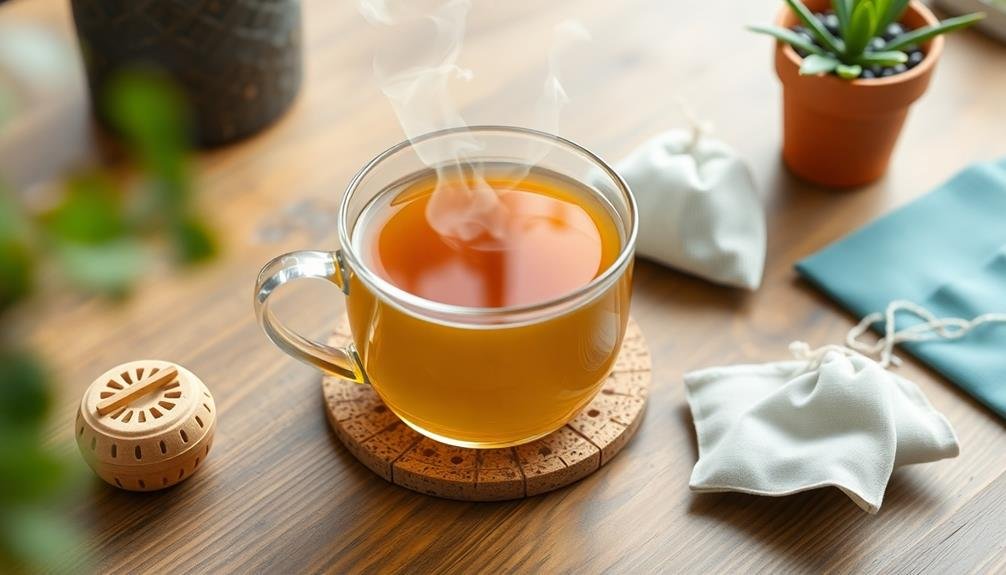
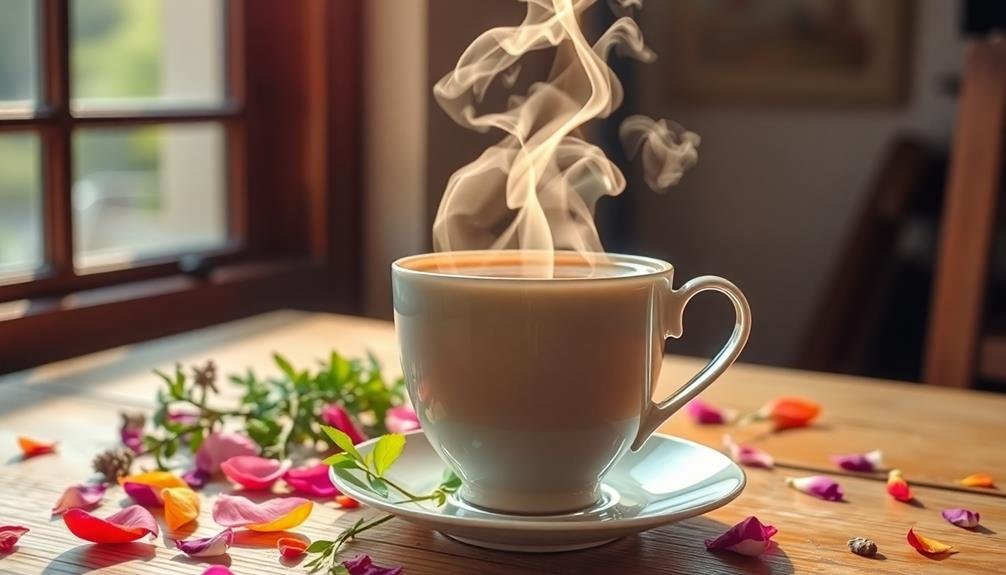
Leave a Reply